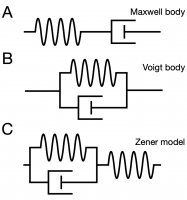Rheologic models consisting of combinations of linear elements, such as and dashpots, are widely used in biophysics to describe the mechanical and, in particular, the viscoelastic behavior of proteins, cells, tissue, and soft matter. Even simple arrangements with few elements often suffice to recapitulate the experimental data and to provide biophysical insights, making them an ideal subject for educational purposes. To provide students with an intuitive understanding of the mechanical behavior of spring and dashpot models, we describe a computer simulation tool, elastic viscous system simulator (ElViS), written in the JavaScript programming language for designing viscoelastic models via a graphical user interface and simulating the mechanical response to various inputs. As an example application, we designed a virtual laboratory course using ElViS that teaches the basic principles of viscoelastic modeling in a gamelike manner. We then surveyed 50 undergraduate students of a 1-semester course in biophysics who participated in the virtual laboratory course. Students felt that the course was a helpful addition to the lecture and that it improved learning success.
Read the full article in The Biophysicist.


